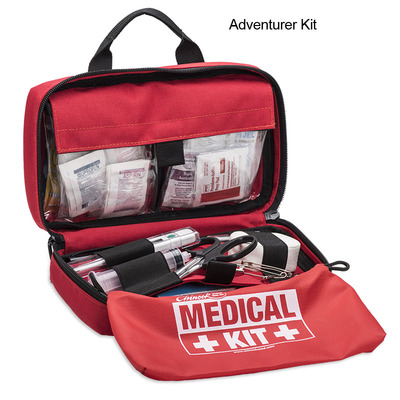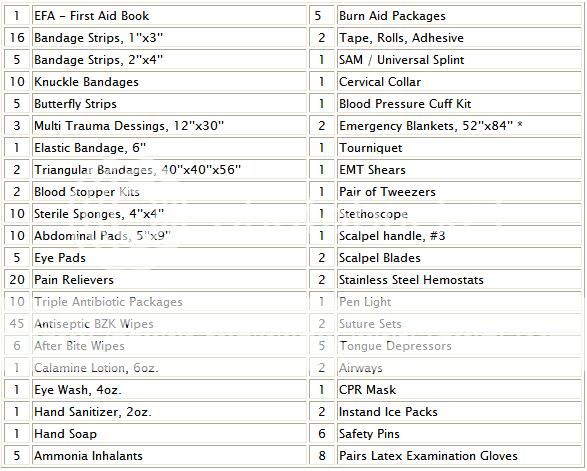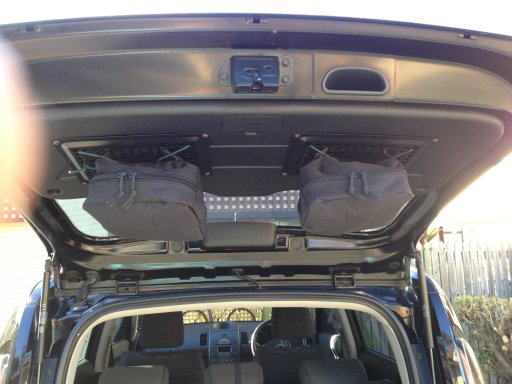
Pathfinder II
Overland Safety Kit: Part I - The First-Aid Kit

A first-aid kit is one of those items you may never need, but when you do, you want it to be suitable for the task at hand. First-aid kits come in many different shapes and sizes, ranging from $5 to $300 and upwards. It can be overwhelming trying to make a selection from the plethora of options. These kits contain anywhere from a few bandages and mild wound treatments, to full-blown field surgical kits.
Fortunately, several manufacturers have recognized this dilemma and developed pre-assembled kits prepped for various lifestyles, durations, and group numbers.
Minimum Requirements - What do I need?
If you like to customize your own kit, there are some basic checklists to build from such as these below:
REI First-Aid Checklist
Red Cross Anatomy of First-Aid Kit
Risk Evaluation - What are you gonna do?
You will need to assess your anticipated risks before selecting or building a kit since it can affect your final list of contents. Here are some questions to consider that may help determine what goes into your kit:
Is anyone in my group allergic (or potentially allergic) to bee stings?
Are there any food allergies to be aware of?
Will I only be riding in my vehicle, or do I plan on hiking some trails, fishing a stream, etc.? What new risks need to be considered when my activity changes?
Are there any specific health issues requiring prescription medication?
Kit Size - Number of People and Trip Duration
Once you determine your contents, the next question is how much of each item will you need. Again, the pre-packaged kits are great for this because they are packaged based on group size and duration. Two companies that have a good reputation for quality kits are:
Chinook Medical Group (Highly recommended by a certified WEMT overlander)
Adventure Medical Kits
Medicine Kit - OTC and Prescriptions
Acid reflux isn't life-threatening, but it can end an enjoyable weekend if you don't have any treatment available. The same goes for headaches, pulled muscles, cramps, diarrhea, sunburn, poison ivy, etc.
Most first-aid kits come already stocked with samples of various OTC medicine which is a good starting point. But let's face it, digging through 30 some-odd packets of first aid supplies, ointments, and small-print pill packs at 1:00 AM is no small task when you have blurred vision from a headache that feels as if a West Virginia coal miner is stuck in your head and trying to get out with a jackhammer.
Instead, something you might consider creating is a dedicated overland medicine kit that has small quantities of medication for these potential medical annoyances. Having this already prepped and staged in your kit will keep you from having to rummage through the medicine cabinet before every trip. These always-ready "go-boxes" are especially handy when you are dealing with the challenge of packing for multiple family members.
Important note: In regards to family members, make sure you bring the proper medication for children since the dosages can vary greatly from the adult versions.
Prescriptions should rank even higher on your list for obvious reasons. These might be tough to keep stocked and up-to-date in your "go-box" so you will need to develop a system to ensure you remember them before you cruise into your campsite 5 hours later and realize they're back home. A detailed, categorized checklist for your overall overland kit can help prevent the forgetfulness that comes when you're rushing to get packed on a Friday evening after work.
Snake Bite Kit - I'll Pass
During your search for a first-aid kit you're going to come across snake-bite kits like this:
It's my (strong) opinion that you pass. The short explanation is that more damage is done to a bite victim when someone attempts to suction, cut, electrically shock, and/or isolate the bite area. Take a look at the first customer review on the product link above if you're up for a very long, detailed read about snake bites and venom effects on the human body. The review author is a herpetologist specializing in venomous snakes and a wilderness medicine practitioner with experience treating many snakebite patients in West and East Africa. He is on a mission to keep people from harming themselves as is evident in his article.
The best immediate treatment for a snake-bite victim is to remain calm and get to a hospital. Keeping the heart rate down for the victim will slow the affects of the venom. Attempting to manipulate the bite area will only increase the speed at which the venom enters the bloodstream
First Aid Training - Got the kit, now what do I do?
So you went all out and bought the biggest, baddest, and highest quality kit you could afford. Your rig throws a belt. You're neck deep in the engine bay getting ready to install your shiny backup belt (which you're so proud you packed in your kit). It's been a while since the alternator has been loose so the tension adjustment bolts are a bit snug. You give it all you've got with that crescent wrench and... slip, lacerating your hand on the fan blade. Now, what do you do?
You've never cleaned and dressed a substantial wound before. Do you think you could patch yourself up? What if this is day one of a week long overland trip? Do you think you'll cancel the whole trip due to a moderate laceration? Let's say you patch the cut up with all the cool supplies from the fancy kit. 3 days go by. The wound is festered and you have a fever. You're 5 hours from the nearest hospital and now a simple wound has turned into a much bigger issue. What is the most likely cause of the infection? Probably improper application of first-aid due to no basic training.
This is just an example of what could happen if you don't educate yourself on using the tool you invested your hard earned money into, which was intended to help prevent a major medical issue. My illustration isn't an attempt to scare you, but to help you visualize the potential issues that can arise from improper use of your most important tool.
Here are some excellent organizations that provide first-aid training:
Red Cross First-Aid & CPR Class
NOLS Wilderness Medical Institute
REI Wilderness Medicine Classes
7/18/16 EDIT: Here is an excellent resource for common first aid topics by the Mayo clinic: First Aid
If you're like me, finding time to go take a class can be tough. Fortunately, there's the Google and YouTube option which is better than nothing. Though I highly recommend taking an actual hands-on course where you can practice the fundamentals.
Also, an injury quick reference guide is a another great addition to the kit. Some higher-end kits include these.
First-Aid Kit Examples - What's some options for the overlander?
Here are a few kits I've come across that may fit the bill for most OB members. These are just suggestions, but they give you a place to start:
Chinook Home and Vehicle Kit
Chinook Adventurer Kit
Adventure Medical Kit - Marine 600 Kit (Waterproof)
Adventure Medical Kit - Sportsman
Adventure Medical Kit - Mountain Series Weekender
If you don't have a First-Aid Kit yet, I hope this article helps point you in the right direction. I myself will be revisiting my current setup after the research I did for this article. Good luck on your selection!
7/18/16 EDIT: "There's an app for that!" While nothing can replace true training, this app by the Red Cross organization is a handy tool to keep yourself fresh on first aid treatment. Google Play Version Here
Please, feel free to continue the discussion below with your questions or comments on this topic.

A first-aid kit is one of those items you may never need, but when you do, you want it to be suitable for the task at hand. First-aid kits come in many different shapes and sizes, ranging from $5 to $300 and upwards. It can be overwhelming trying to make a selection from the plethora of options. These kits contain anywhere from a few bandages and mild wound treatments, to full-blown field surgical kits.
Fortunately, several manufacturers have recognized this dilemma and developed pre-assembled kits prepped for various lifestyles, durations, and group numbers.
Minimum Requirements - What do I need?
If you like to customize your own kit, there are some basic checklists to build from such as these below:
REI First-Aid Checklist
Red Cross Anatomy of First-Aid Kit
Risk Evaluation - What are you gonna do?
You will need to assess your anticipated risks before selecting or building a kit since it can affect your final list of contents. Here are some questions to consider that may help determine what goes into your kit:
Is anyone in my group allergic (or potentially allergic) to bee stings?
Are there any food allergies to be aware of?
Will I only be riding in my vehicle, or do I plan on hiking some trails, fishing a stream, etc.? What new risks need to be considered when my activity changes?
Are there any specific health issues requiring prescription medication?
Kit Size - Number of People and Trip Duration
Once you determine your contents, the next question is how much of each item will you need. Again, the pre-packaged kits are great for this because they are packaged based on group size and duration. Two companies that have a good reputation for quality kits are:
Chinook Medical Group (Highly recommended by a certified WEMT overlander)
Adventure Medical Kits
Medicine Kit - OTC and Prescriptions
Acid reflux isn't life-threatening, but it can end an enjoyable weekend if you don't have any treatment available. The same goes for headaches, pulled muscles, cramps, diarrhea, sunburn, poison ivy, etc.
Most first-aid kits come already stocked with samples of various OTC medicine which is a good starting point. But let's face it, digging through 30 some-odd packets of first aid supplies, ointments, and small-print pill packs at 1:00 AM is no small task when you have blurred vision from a headache that feels as if a West Virginia coal miner is stuck in your head and trying to get out with a jackhammer.
Instead, something you might consider creating is a dedicated overland medicine kit that has small quantities of medication for these potential medical annoyances. Having this already prepped and staged in your kit will keep you from having to rummage through the medicine cabinet before every trip. These always-ready "go-boxes" are especially handy when you are dealing with the challenge of packing for multiple family members.
Important note: In regards to family members, make sure you bring the proper medication for children since the dosages can vary greatly from the adult versions.
Prescriptions should rank even higher on your list for obvious reasons. These might be tough to keep stocked and up-to-date in your "go-box" so you will need to develop a system to ensure you remember them before you cruise into your campsite 5 hours later and realize they're back home. A detailed, categorized checklist for your overall overland kit can help prevent the forgetfulness that comes when you're rushing to get packed on a Friday evening after work.
Snake Bite Kit - I'll Pass
During your search for a first-aid kit you're going to come across snake-bite kits like this:
It's my (strong) opinion that you pass. The short explanation is that more damage is done to a bite victim when someone attempts to suction, cut, electrically shock, and/or isolate the bite area. Take a look at the first customer review on the product link above if you're up for a very long, detailed read about snake bites and venom effects on the human body. The review author is a herpetologist specializing in venomous snakes and a wilderness medicine practitioner with experience treating many snakebite patients in West and East Africa. He is on a mission to keep people from harming themselves as is evident in his article.
The best immediate treatment for a snake-bite victim is to remain calm and get to a hospital. Keeping the heart rate down for the victim will slow the affects of the venom. Attempting to manipulate the bite area will only increase the speed at which the venom enters the bloodstream
First Aid Training - Got the kit, now what do I do?
So you went all out and bought the biggest, baddest, and highest quality kit you could afford. Your rig throws a belt. You're neck deep in the engine bay getting ready to install your shiny backup belt (which you're so proud you packed in your kit). It's been a while since the alternator has been loose so the tension adjustment bolts are a bit snug. You give it all you've got with that crescent wrench and... slip, lacerating your hand on the fan blade. Now, what do you do?
You've never cleaned and dressed a substantial wound before. Do you think you could patch yourself up? What if this is day one of a week long overland trip? Do you think you'll cancel the whole trip due to a moderate laceration? Let's say you patch the cut up with all the cool supplies from the fancy kit. 3 days go by. The wound is festered and you have a fever. You're 5 hours from the nearest hospital and now a simple wound has turned into a much bigger issue. What is the most likely cause of the infection? Probably improper application of first-aid due to no basic training.
This is just an example of what could happen if you don't educate yourself on using the tool you invested your hard earned money into, which was intended to help prevent a major medical issue. My illustration isn't an attempt to scare you, but to help you visualize the potential issues that can arise from improper use of your most important tool.
Here are some excellent organizations that provide first-aid training:
Red Cross First-Aid & CPR Class
NOLS Wilderness Medical Institute
REI Wilderness Medicine Classes
7/18/16 EDIT: Here is an excellent resource for common first aid topics by the Mayo clinic: First Aid
If you're like me, finding time to go take a class can be tough. Fortunately, there's the Google and YouTube option which is better than nothing. Though I highly recommend taking an actual hands-on course where you can practice the fundamentals.
Also, an injury quick reference guide is a another great addition to the kit. Some higher-end kits include these.
First-Aid Kit Examples - What's some options for the overlander?
Here are a few kits I've come across that may fit the bill for most OB members. These are just suggestions, but they give you a place to start:
Chinook Home and Vehicle Kit
Chinook Adventurer Kit
Adventure Medical Kit - Marine 600 Kit (Waterproof)
Adventure Medical Kit - Sportsman
Adventure Medical Kit - Mountain Series Weekender
If you don't have a First-Aid Kit yet, I hope this article helps point you in the right direction. I myself will be revisiting my current setup after the research I did for this article. Good luck on your selection!
7/18/16 EDIT: "There's an app for that!" While nothing can replace true training, this app by the Red Cross organization is a handy tool to keep yourself fresh on first aid treatment. Google Play Version Here
Please, feel free to continue the discussion below with your questions or comments on this topic.
Last edited:











